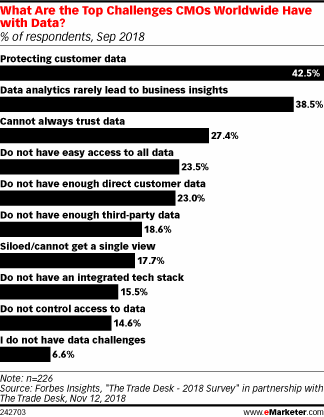
What You Need to Know to Achieve Data Orchestration
Individually, the instruments in an orchestra sound beautiful. But when they’re put together, they become something much more than a “pretty sound.” The blended tones tell a larger story that takes you on a journey. Think of data orchestration in the same way. Data orchestration is a process that pulls audience data from different channels and devices, mixes/matches the data across these touch points, and adds data collected from launched campaigns to existing segments for a more accurate understanding of the customer journey. The result? Holistic audience views that create deeply informed cross-channel campaigns — all from one platform.
Why Data Is Such A Big Problem
By creating 360 audience views and allowing companies to activate that holistic insight across all channels, data orchestration solves one of the top marketing challenges: making data-driven decisions. Yet, according to a new study by Snowflake Computing and Harvard Business Review, only 5% of retail and CPG enterprises qualify as data-driven, half of the survey average (10%).
But what does data-driven decision-making really look like? It can mean justifying marketing expenses, prioritizing one channel over another, or deciding how to personalize campaigns. In another worldwide study conducted by Ascend2, 63% of respondents said that data-driven personalization is a difficult tactic to execute. No other tactic listed in the survey — including content marketing, email marketing, and search engine optimization — warranted such difficulty.

Personalization isn’t the only problem marketers face when it comes to data. In fact, according to a recent Forbes Insights Survey, the top challenges cited were protecting customer data, data analytics (data-driven decisions), and untrustworthy data.
So, what’s holding back marketers across these different industries from solving the data problem? The biggest challenge cited was human in nature; 44% said they lacked the digital and data analytic skills to transform. More than one-third cited internal resistance to change while 29% blamed legacy processes. Another huge obstacle is clarity surrounding the different types of technology and their capabilities for solving major marketing problems.
The Difference Between Data Orchestration and Customer Data Platforms
When it comes to data, there are many different types of technology that promise they have what it takes to manage it:
- Data Orchestration Platforms
- Customer Data Platforms
- Enterprise Data Warehouse
- Customer Identity and Access Management
- Customer Relationship Management
- Data Management Platform
- Digital Experience Platform
- Digital Personalization Engine
- Marketing Dashboards
- Master Data Management
- Multichannel Marketing Hub
- Tag Management System
For our purposes, let’s focus on the platform most closely related to data orchestration: the customer data platform. According to Gartner, a customer data platform is “a marketing system that unifies a company’s customer data from marketing and other channels to enable customer modeling, and optimize the timing and targeting of messages and offers.”
Gartner further explains that most companies seek technology like a CDP to “centralize data collection, unify customer profiles from disparate sources, create and manage segments, and activate those segments in priority channels.”
The problem? Many of these technologies overlap and even within certain categories, there isn’t much consistency from platform to platform. For example, not all data management platforms process personally identifiable information, though some do. And not all customer data platforms activate your audience segments across every marketing channel.
Data orchestration, however, does all of the key things the best CDP should do reliably as well as:
- Identity resolution: Data orchestration uses audience ID matching to integrate disparate audience touchpoints, solving who customers are across different channels and devices and merging that information into holistic audience profiles. Then, those holistic audience profiles can be used to create more accurate segments that are activated across all channels.
- Continuous segment enrichment: By running campaigns in a data orchestration platform, you’ll collect deeper insights on your customers which will automatically feed back into your segments to improve audience understanding over time. And with more accurate audience insights, you can easily identify your highest value segments and which aspects of your campaigns are attracting your "best" customers
- Automatic campaign budget optimization: With marketers using different segments to run their campaigns on each channel, it can be hard to determine why some efforts perform and others fail. By launching your campaigns using standardized segments across all channels, data orchestration can help determine what’s causing success and in turn, dynamically allocate your budget to support it.
There are a lot of big promises in the software industry about data and how it can help your brand. Most platforms that help manage data have a particular strength, but few are rarely designed with end-to-end marketing in mind. By integrating all of your data sources and activating that 360 audience information cross-channel, data orchestration allows you to ask and find answers to the questions you have about your audience — no matter how granular. To learn more about the different ways data orchestration can amplify your team’s marketing strategy, learn more about our data orchestration solutions.
Share:
Got a project?
Harness the power of your data with the help of our tailored data-centric expertise.
Contact us